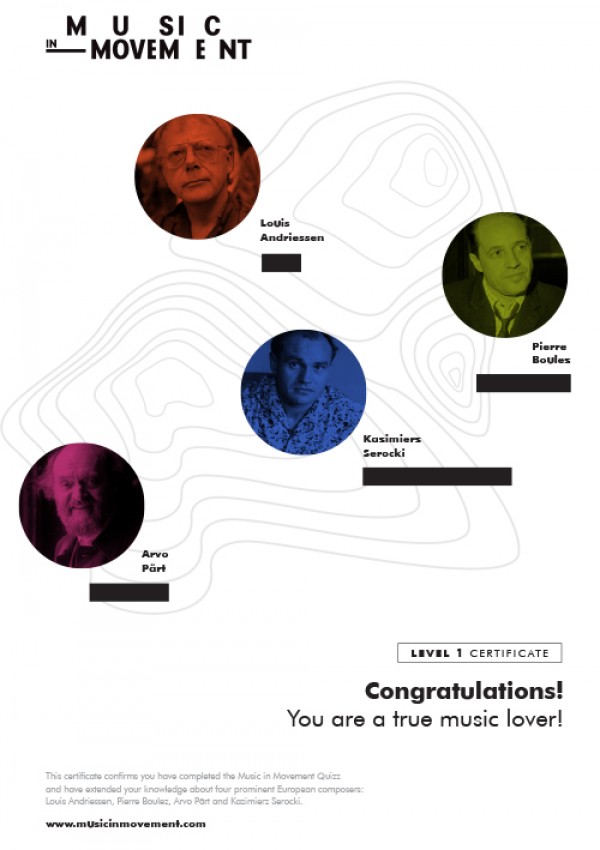MiM quiz – Expert level / Education
Remember, this quiz is not about testing your knowledge about contemporary music. It's all about getting to know the four composers - their music, techniques, but also inspirations and private stories. We invite you to take on this challenge - discover the universe of four personalities and dive in into their music.
In which example is the sound of instruments transformed electronically?
Choose one or more:
Pierre Boulez – …explosante-fixe… for MIDI flute, two flutes, ensemble and electronics (1991–93).
Louis Andriessen – De Tijd for choir and orchestra (1980–81). Louis Andriessen sometimes used electronics, but the sophisticated colours and effects in the piece are achieved without electronics.
Kazimierz Serocki – Pianophonie for piano with electronic transformation of sound and orchestra (1979).
Arvo Pärt – Miserere (1989–92). Arvo Pärt did not use electronics, the reverberation is, of course, entirely natural.
Creative periods - Pierre Boulez
Which work by the composer is earlier? Which is later?
The earlier one should be indicated.
Discreet use of live electronics (delay, reverb diversification) points to a later period of Pierre Boulez creations, associated with the IRCAM technology (Dialogue de l'ombre double, 1985). In the case of Le marteau sans maître (1954), the earlier date is indicated, inter alia, by the melody characteristic for the avant-garde of the 50s.
Composers and trends of music of the recent and distant past had a considerable influence on all four composers. Link a source of inspiration to a composer.
The affinity between Stravinsky’s and Louis Andriessen’s music is evidenced not only by the Dutch composer’s works but also by a book devoted to the Russian’s oeuvre which Louis Andriessen co-authored (The Apollonian Clockwork).
The impact of Bartók’s music can easily be discerned in Kazimierz Serocki’s oeuvre of the first half of the 1950s, for example, in his Sonata for piano.
To a large extent the style and techniques Arvo Pärt developed in the late 1960s and early 1970s were a result of his studies of Renaissance and late medieval polyphony, and Gregorian chant.
The avant-garde of the 1950s, including Pierre Boulez, considered the music of Anton Webern to be its predecessor and model to be developed further.
Creative periods - Louis Andriessen
Which work by the composer is earlier? Which is later?
The earlier one should be indicated.
Louis Andriessen’s music is often divided into pre- and post-De Staat (1972):
- Ittrospezione III (1965) – music that fits in well with the avant-garde of the 1960s.
- Excerpt from De Materie (first part) - its characteristic features include clear pulsation, repetitions, Stravinsky and jazz influences.
Here are some names of performers important to the four composers for some reason. Link them to the right name.
The conductor Reinbert de Leeuw, together with the Dutch ensembles Schönberg Ensemble and Asko Ensemble (now combined into one Asko/Schönberg Ensemble) performed and premiered many of Louis Andriessen’s works.
Maurizio Pollini is a brilliant interpreter of Pierre Boulez’s piano sonatas, especially No. 2, which he believes is a milestone in the repertoire for the instrument on a par with Beethoven’s sonatas.
Gidon Kremer is a great advocate of Arvo Pärt’s music – at his request the composer wrote Tabula Rasa; Kremer was also the first performer of Fratres in the version for violin and piano.
Les Percussions de Strasbourg premiered Kazimierz Serocki’s percussion sextet Continuum.
Inspirations from outside European classical music were important to each of the four composers
The task is to link the source of inspiration to the right name.
Although elements of Polish folklore found their way into Kazimierz Serocki’s music only for a few years and to some extent were associated with a need for a compromise with the ideology of Stalinist Poland, the artistic results of these inspirations are still worthy of note.
Louis Andriessen’s creative imagination was under the influence of jazz from his early youth.
Although generally Pierre Boulez was far from imitating folk music or music of other cultures, the sound of non-European instruments, like those in the Indonesian gamelan, often attracted him more than the conventional sound of classic European ensembles and orchestras.
The term “tintinnabuli”, which Arvo Pärt uses to describe his own style and technique denotes “little bells” (Lat.).
Well done!
We hope you enjoyed the experience!
You can now share & save your MiM certificate!

